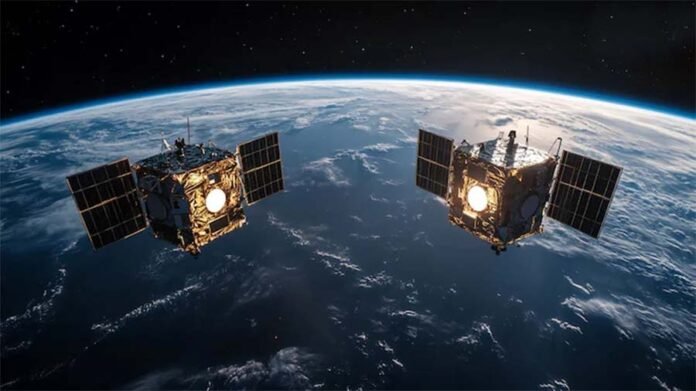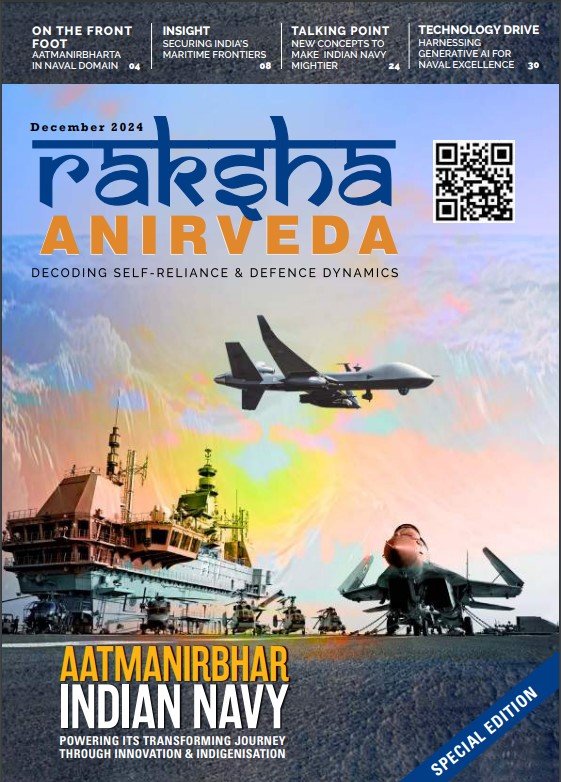After successfully launching the formation flying of two spacecraft Proba-3 of the European Space Agency (ESA) on December 5, India is now on the threshold of excelling in space docking. The Indian Space Research Organisation (ISRO) is preparing to launch its most significant mission – Space Docking Experiment (SpaDeX). It is a built-up to the nation’s human spaceflight capability. The SpaDeX mission will experiment with space docking technology, crucial for the Bharat Antariksh Station (BAS), Gaganyaan, and other related missions. The SpaDeX will be launched on December 30, 2024, from Satish Dhawan Space Centre in Sriharikota, Andhra Pradesh.
Space Docking
Space Docking is a controlled mechanical process for spacecraft orbital mating. It begins with the initial approach of the spacecraft and its first contact. It is performed with a docking system that includes control avionics and docking assemblies. Methods for the design, simulation and testing of different docking systems have been researched and reviewed since 1984. The initial conditions for docking are provided by a rendezvous system and the docking assemblies themselves perform the mechanical process of spacecraft mating.
This process is long-drawn and comprises various stages, and takes tens of hours depending upon several factors. Docking involves aligning the spacecraft docking adaptor with the target docking point and then controlling the spacecraft so that it docks with zero relative velocity – both angular and linear, zero angular error and zero position error. It is a six-degrees-of-freedom (6DOF) problem.
Technological Legacy
India would be the fourth country to join this elite league of nations with proven space docking capability. Russia, the US, and China possess this significant capability. In 2011, China accomplished its first space docking mission when the Chinese Shenzhou-8 spacecraft docked with space lab module Tiangong-1, more than 343 km above the surface of the Earth. Before that in 1967, the erstwhile USSR achieved docking through its Kosmos 186 and 188 missions, the unmanned modules of Soyuz vehicle. This was followed by the US, with the docking of the US’s Apollo with the Russian Soyuz capsule in 1975. Since then, space docking operations have been undertaken by these countries as a matter of routine. This year, Elon Musk’s SpaceX became the first private company to have undertaken docking onto the International Space Station (ISS).
The SpaDeX mission comprises two spacecraft of the 400 kg category, termed ‘Chaser’ and ‘Target’. With this mission, costing Rs 124 crore, India will join the elite league of nations with proven space docking capability. Russia, the United States, and China possess this significant capability
Indian Space Docking Experiment – A Cosmic Tango
Closer home, Space Docking Experiment (SpaDeX) is a twin spacecraft mission related to formation flying, orbital rendezvous, and docking. It is part of the building block, phase-wise development approach being followed for the development of Bharat Antariksh Station (BAS), as a completely indigenous effort. M Sankaran, Director, UR Rao Satellite Centre (URSC) has informed the media that the SpaDeX mission comprises two spacecraft of the 400 kg category, termed as ‘Chaser’ and the ‘Target’. Mission launch is scheduled for December 30, 2024, onboard PSLV-C60 from the first launch pad of Satish Dhawan Space Centre, Sriharikota. The mission cost is projected at Rs 124.47 crore.
The mission will test the docking spacecraft coming together and connecting in space. It will also test how well the combined spacecraft maintains stability and control after docking, thereby ensuring smooth operations for future missions.
As part of space sector reforms initiated by the Government of India, New Space India Limited (NSIL) was established in March 2019 to act as an exclusive public-sector aggregator for both demand and supply of space assets on a commercial basis, including various space services. Under the aegis of NSIL, it is for the first time that a private sector company, Hyderabad-based Ananth Technologies Private Limited (ATL) is involved in such an experiment. SpaDeX project is a stellar example of a public-private partnership in the space sector, paving the way for end-to-end technology transfer and operationalisation of a niche capability. The technology for design has been transferred by ISRO to ATL and they have undertaken the complete manufacturing, fabrication, assembly, integration and testing (AIT). Extensive simulations have been conducted jointly by ISRO and ATL.
SpaDeX is aimed at testing and demonstrating ‘low impact cooperative docking’. The experiment will be conducted in the low earth orbit (LEO), at approximately 700 km above the surface of the Earth, wherein the satellites will autonomously locate and connect. The tests will last up to approximately ten days of the launch. The whole experiment can be described as a space dance – a cosmic tango.
The experiment will be conducted in the low earth orbit (LEO), at approximately 700 km above the surface of the Earth, wherein the satellites will autonomously locate and connect. The tests will last up to approximately ten days of the launch. The experiment can be described as a space dance – a cosmic tango
Initially, these spacecraft will be released individually with a small relative speed, allowing them to drift apart at a gradual rate. After they reach a distance of about 10 to 15 km, the drift between the two satellites will be arrested; the ‘Chaser’ satellite will be moved closer to the ‘Target’ satellite in incremental steps and brought closer and closer to a few metres, ultimately leading to docking. It is a true test of avionics and docking capabilities allowing complete freedom of movement in all six axes. Operating in such close proximity, the two spacecraft will be steered by a combination of optical and laser sensors.
Once docked, the two spacecraft will be tested for their stability and integration. The complete latches and electromechanical functioning will be ascertained through certain light manoeuvres.
Later they will be separated and made to perform their original tasks for their respective payloads, in this case, radiation monitoring and imaging respectively. Radiation monitoring would be employed to estimate electron and proton radiation in space, which is crucial for future human space flights. The imaging payload is also a tech demonstration for exploring how to achieve high-performance capabilities in smaller, nano-sized satellites.
Importance of SpaDeX for India
SpaDeX is the first step towards mastering the rendezvous and docking technology, considered essential for India’s Chandrayaan-4, human spaceflight programme and building Bharat Antariksh Station (BAS) assembly, spacecraft refueling, spacecraft repairs etc.
This experiment is crucial for ISRO to develop the skills needed for advanced missions, such as human spaceflight and lunar sample returns. SpaDeX is needed for ISRO to enhance its role in numerous space activities that will enhance the space capabilities of the nation. Docking is likely to be employed in various space activities like refueling, extending their life span, maintaining and repairing a damaged spacecraft while in space, deorbiting a spacecraft, relocating spacecraft to a different orbit, and attaching various equipment and modules to a spacecraft. It is going to be of utmost importance for docking operations of crew modules for astronauts into the Indian BAS, making it possible to build advanced facilities in orbit and expand space exploration.
ISRO has followed a highly collaborative and farsighted approach in designing and developing the docking capability for the nation. SpaDeX’s docking mechanism conforms to International Docking Standards, promulgated by NASA after years of research and collaborative approach with other space-faring nations. SpaDeX follows the standard three-petal mechanism, which will make this capability relevant and acceptable amongst various space-faring nations enabling collaboration in future international projects. ISRO has further made value enhancements to this design making it better and reliable offering better control over the docking process. Another highlight of SpaDeX is that ISRO has obtained patents for the technology used.
SpaDeX’s docking mechanism conforms to International Docking Standards, promulgated by NASA. SpaDeX mission is crucial for ISRO as it is key to achieving India’s long-term space exploration goals, including manned spaceflight, satellite maintenance, and space station construction
Conclusion
A successful SpaDeX mission will help ISRO equip with the basic technology and capacity required for the construction of a space station and would make it possible for India to undertake space exploration on a larger scale. Most space technologies being dual use, docking capability will offer multiple use cases in various space and counter-space operations towards building comprehensive space capability for the nation. A successful experiment would also pave the way for docking operation with a ‘non-cooperative spacecraft’ at a future date.
In the forthcoming few years, ISRO is pushing boundaries and has a few sets of complex missions as a commitment to advancing space exploration and technology. SpaDeX is key to achieving India’s long-term space exploration goals, including manned spaceflight, satellite maintenance, and space station construction. The mission’s success could open up a range of opportunities for India in space exploration, including long-duration human spaceflight, the construction of large space structures, and commercial possibilities in satellite servicing and space debris management.
Mastering rendezvous and docking operations is going to be a historic feat in the space arena that will catapult India into an elite league of nations capable of executing complex space operations. Involving private space companies in the experiment right from the design and development stage is another far-reaching step by ISRO.
SpaDeX mission is part of docking and berthing operations. ISRO is also known to be preparing for robotic arm experiments, albeit separately. It will enhance ISRO’s capability to grapple with space objects and contribute to deploying the robotic arm for debris mitigation, aiding the global effort of making space operations sustainable and safe.
–The writer is an IAF veteran and has been involved in air operations, intelligence and strategic matters. He has served as Assistant Chief of Air Staff (Off Ops) at Air HQ and Assistant Chief of Integrated Defence Staff (Tech Int) at HQ – IDS, appointments related to offensive operations, UAV, space and ISR matters. The views expressed are of the writer and do not necessarily reflect the views of Raksha Anirveda






